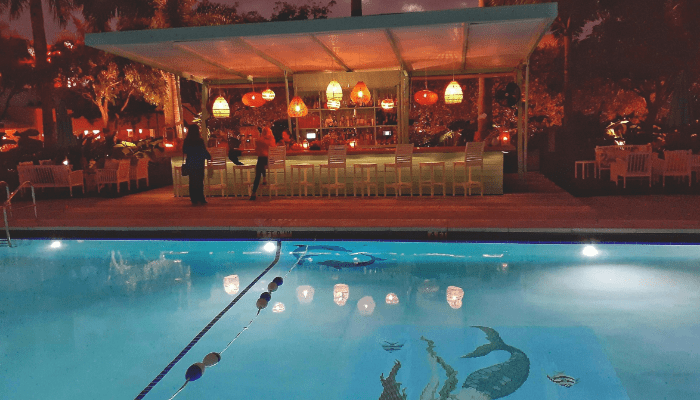Key Takeaways
- Common swimming pool insects include backswimmers, water boatmen, mosquito larvae, and thrips. Some bite, others feed on algae or attract predators.
- Bugs show up when water is still, dirty, or full of food sources. Algae, debris, and bright lights at night are big invitations.
- Remove them with a layered approach: skim daily, brush and vacuum walls, shock the pool, use algaecide, and clean filters and skimmers.
- Prevention is key: maintain chlorine levels, run the pump, use a pool cover, trim plants, and switch to bug‑repelling lights.
- Natural repellents work around the deck, but inside the pool, proper chemical balance and regular cleaning are the most effective.
- If bugs keep coming back, call a professional. Persistent pests often mean hidden algae or filtration issues.

There are more than 10 million residential pools in the U.S., and insects seem to think every one of them is an open invitation.
If you’ve ever skimmed a pool only to find a backstroking bug staring back at you, you’re not alone. Some swim, some bite. Some just die dramatically in the deep end. But none of them are paying rent, and they’re ruining the vibe.
Whether it’s water boatmen doing laps, backswimmers biting ankles, or ants treating your pool like Coachella, insects in your pool are more than a nuisance. They’re a sign something’s off. And no, it’s not your pool party playlist.
You don’t need a biology degree to evict these unwelcome guests. But you do need to know what’s attracting them, how to get rid of them for good, and most importantly how to keep them from ever coming back.
In this guide, we’ll break down which bugs are which (some are surprisingly helpful!), why they keep showing up, and what actually works to banish them. This isn’t about dumping random chemicals into your water and hoping for the best. It’s about smart, strategic pool care and yes, it’s easier than you think.
Let’s dive into the insect underworld of your swimming pool.

What Are Swimming Pool Insects?
Let’s call it what it is: gross. Bugs in the pool aren’t just annoying, they’re a flashing neon sign that something’s off.
“Swimming pool insects” is a polite way of describing the small winged, crawling, or wriggling creatures that think your pool is a five-star resort. These aren’t your average outdoor bugs. Some of them swim like Olympians. Others reproduce like it’s their full-time job. All of them? Uninvited.
Most of the time, bugs end up in your pool for two reasons: food or shelter. Algae is their buffet. Still water? A dreamy nursery. Dim lights at night? A flashing welcome sign. The key to getting rid of them is figuring out what’s attracting them and cutting it off at the source.

Identifying the Most Common Swimming Pool Water Bugs
Here’s your lineup of usual suspects. Knowing who’s who helps you know what to do.
1. Backswimmers
Looks harmless. Swims on its back. Bites like a wasp. These guys are the aggressive ones, often mistaken for water boatmen (more on them in a sec). If you’ve been bitten in your pool, a backswimmer was probably the culprit. They eat other bugs, which sounds helpful until you realize they’re biting you too.
2. Water Boatmen
The chill cousins of backswimmers. They don’t bite. They don’t hunt. They mostly eat algae and organic matter, which sounds great until their presence attracts predators. Like, you guessed it, backswimmers.
3. Thrips
Tiny, fast, and annoying. They’re not technically water bugs, but they fall into pools from nearby plants and make themselves at home. Not dangerous, just irritating.
4. Mosquito Larvae
These aren’t “bugs in the pool.” They’re bugs about to be in the air, in your yard, and biting your ankles. Standing water gives mosquitoes a perfect place to breed. If you see larvae, act fast.
5. Gnats, Ants, Wasps
These bugs don’t live in the water, but they’re drawn to it. Spilled drinks, wet surfaces, and shady corners bring them running. Some drown. Some fly around your face. None are cute.

Why Are Bugs Attracted to Your Pool?
Insects aren’t diving in for the fun of it. Your pool might be inviting them without you realizing it.
- Algae: Green water equals bug buffet. Even a slight green tint can bring in water boatmen and everything that follows them.
- Organic debris: Leaves, grass clippings, dead bugs, they all feed something. And whatever eats it probably swims.
- Stagnant water: No movement? Mosquitoes love that.
- Warmth and light: Nighttime lighting + warm water = all-you-can-eat insect invitation.
- Unbalanced pH: Bugs don’t care about your pH, but algae and bacteria do. And they attract the bugs.
If your pool looks clean but still has bugs, check the hidden corners. Skimmer baskets, steps, and filters are party zones for pests.
How to Get Rid of Swimming Pool Insects
Forget one-size-fits-all solutions. You need a layered attack. Here’s your bug-busting blueprint.
Step 1: Skim Like You Mean It
Grab that net and go to town. Get the bugs, the leaves, the junk, everything. The less food and shelter, the fewer bugs tomorrow. Do this daily if you’ve got a bug problem.
Step 2: Vacuum and Brush
Manual vacuuming isn’t fun. Do it anyway. Bugs can lay eggs on pool walls or hide in debris on the floor. Brush down the walls and steps to knock off anything trying to hang around.
Step 3: Shock It
If you haven’t shocked your pool recently, now’s the time. A solid chlorine shock wipes out algae, larvae, bacteria, and anything planning to build a condo in your pool filter. Follow the instructions, no winging it.
Step 4: Use an Algaecide
Algaecide prevents the green stuff that attracts the bugs. Apply after shocking. Keep it in your regular maintenance plan, not just emergencies.
Step 5: Clean Filters and Skimmers
Don’t let filters become bug breeding zones. Clean them out. Rinse, backwash, replace if needed. A dirty filter is a motel for pests.
Step 6: Zap Them Outside the Pool
Bug zappers, citronella torches, and motion-activated sprinklers can keep flying insects away from the pool area. Less flying around = less falling in.

Preventing Insects from Returning
You’ve cleared the bugs. Now let’s keep it that way. Here’s what works.
- Keep your chlorine levels steady. Not just after parties or rain. Weekly checks.
- Run the pump daily. Circulating water keeps things fresh and unappealing to mosquitoes.
- Use a pool cover when it’s not in use. Especially at night.
- Trim back trees and shrubs. Bugs drop from branches like skydivers.
- Switch to bug-repelling lights. Yellow-toned bulbs or LED options attract fewer insects.
- Clean up after swimming. Food, drinks, sunscreen spills, they all attract ants and wasps.
If you’re near a wooded area or lake, consider extra defense. Some environments are just buggier. That doesn’t mean you have to accept it.

Natural vs Chemical Solutions: Which Works Better?
You’ve got options. But not all of them are effective.
Chemicals (chlorine, algaecide) are the heavy lifters. If your pool’s already swarming, go this route first. They work fast and hit the root cause: algae and bacteria.
Natural solutions, like peppermint oil, essential oil sprays, and vinegar can work as repellents outside the pool. But don’t rely on them to clean your water. They’re best for prevention around the deck, not cleanup in the deep end.
Want to keep it eco-friendly? Great. Just be smart about where the line is. Prevent naturally, treat professionally.

When to Call a Pool Professional
You’ve shocked, scrubbed, filtered, skimmed and the bugs keep coming back. At some point, you need backup.
If the water stays cloudy, the bugs are multiplying, or something smells off, it might be time for a pro. Persistent bug issues can signal hidden algae blooms, filter problems, or circulation failures.
And if you’re just tired of being on bug patrol every week? Pool maintenance companies exist for a reason. No shame in outsourcing.
Conclusion
Look, bugs belong in the wild, not backstroking across your chlorine oasis.
We’ve covered the big ones: backswimmers, water boatmen, mosquito larvae, plus the lesser-known pool crashers like gnats and thrips. You now know why they’re drawn to your water, how to boot them out, and how to make sure they don’t come crawling (or flying) back. It’s part maintenance, part science, and part knowing how to outsmart something with a brain smaller than a poppy seed.
The fix doesn’t have to be complicated. Keep the water balanced. Remove organic debris. Stay on top of algae. And use that pool cover like you mean it.
Think of your pool like a VIP lounge. If bugs can get in, something’s wrong with your guest list.
Whether you’re a seasoned pool owner or just learning the ropes, the difference between a bug-infested swamp and a sparkling blue paradise comes down to consistency, not luck.
So take 10 minutes today. Skim the surface. Test the pH. Check the corners. Your pool deserves it. And so do you.
Bug-free summer? Yes, please.
Want a pool that bugs avoid in the first place?
Oásis Biosistema designs chemical-free natural pools with better circulation, no algae, and fewer pests by design.
FAQ
What is this bug swimming around in my pool?
Bugs swimming in your pool are often water beetles, backswimmers, or boatmen. They’re attracted to light and still water. While not dangerous, they can be annoying. Regular skimming, keeping the pool covered at night, and maintaining proper chlorine levels help prevent these insects from settling in your pool.
How do you get rid of water striders?
To get rid of water striders, reduce their food source and disrupt their habitat. Skim insects regularly, keep the water moving with a fountain or pump, and trim nearby vegetation. Avoid leaving lights on at night that attract bugs, and maintain clean water to discourage them from staying.
How to get rid of parasites in a pool?
Eliminate parasites by shocking your pool with the correct chlorine levels, brushing walls, and running the filtration system continuously until clear. Test water regularly to maintain proper chemical balance. A clean, well‑chlorinated pool prevents parasites like Cryptosporidium from surviving, keeping swimmers safe and the water crystal clear.
What is a pool mite?
A pool mite is a tiny aquatic insect that can appear in stagnant or poorly maintained water. They often feed on algae or organic debris and aren’t harmful to humans but indicate your pool needs better cleaning. Regular filtration, brushing, and balanced chemicals help keep pool mites away.



